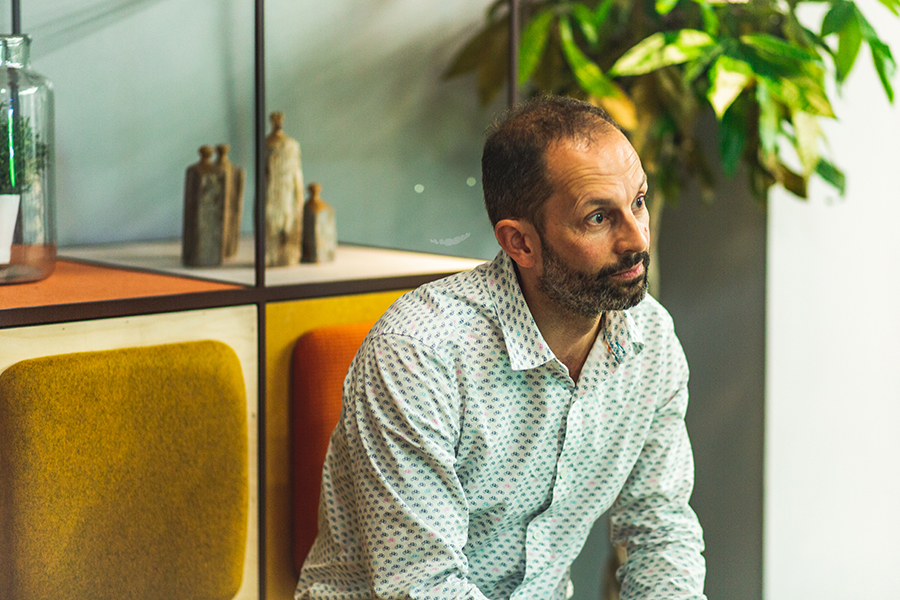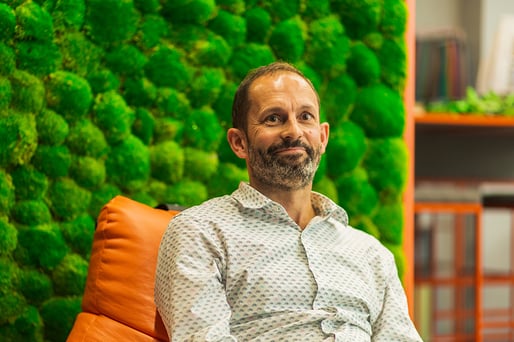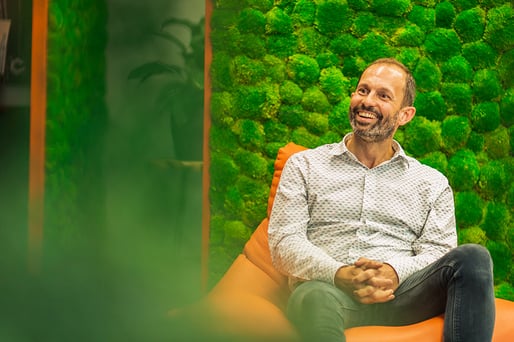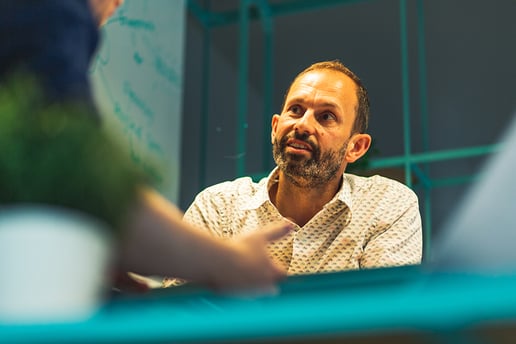|
Richard Russell is the founding Director Innerspace Cheshire, one of the foremost suppliers of natural materials within the interior design industry. Creatif spoke to Richard about Innerspace's approach to sustainability, the company's varied history and the importance of incorporating biophilic principles from the outset of any design process. Also, Richard spilled the beans about some of Innerspace's new product developments.
Creatif: You initially start off in textiles and carpet tiles. What brought about the change from fabrics natural materials? Richard Russell: Innerspace used to be the agents for a carpet company and a big one at that. We grew the business quite a lot but they got taken over by an American company who didn’t wanted to use agents so we got sacked! But in that role, we developed loads of great friends in the industry; loads of great designers, architects and so on. So when our old venture went belly up, we were left with a really good customer base and no product. Rather than try and replicate what we’d already done – which would be very challenging – we thought we’d ask our friends what they’d like to see from us. They told us lots about the things they want and the trends they’d seen, and we went away and did the research. From that process, we felt that there was a clear gap in terms of biophilic materials and bringing that to designers.
Creatif: Did you have any kind of interest in biophilia at that point? RR: Yes. As a company, and as individuals, we were always really keen on sustainability. Obviously, when we were working for another company, we were governed by their values we couldn’t really be true to ourselves. So when the opportunity arose, we all knew we wanted to do something sustainable and to be frank, the chance to manufacture something was also really important as it was something we’d never done before and it’d allow us to control our own destiny. Biophilic design was a natural fit. Creatif: Today, biophilic design is something of a staple in the workplace. But there was a time when the idea of ‘bringing the outside in’ was a novel, almost alien concept. In your opinion, how have opinions changed over the years? RR: Biophilic design has become a buzz word in the past two to five years but if you go back to the 1980s you can find research papers talking about why people aren’t designed to live in grey boxes [and] how we need to see horizons, greenery and nature to feel whole. The concept of biophilic design and using natural materials has always been there and I think, recently, it’s become this zeitgeist that everyone’s aware of. Creatif: Much in the same way that in a shorter period of time, there has been a wider societal awakening on the topics of sustainability and the natural world. The ‘Blue Planet’ factor, if you will. RR: Absolutely, whether it’s because of Blue Planet or because of something else, there’s definitely been some mainstream influences over workspace design. That’s both really cool and really important. There are so many articles and news stories out there about the environment, about the war on plastics, the use of microplastics and so on, and that’s where the crossover happens – be it consciously or subconsciously from designers and clients. Where we want Innerspace to be is at the crossing point of the two zeitgeists of biophilic design and the war on plastic. By producing natural materials, manufactured and sourced sustainably, we’re right in the middle of that – and that’s where we want to stay.
Creatif: Manufactured sustainably? RR: Every installation is made to order. We don’t manufacture ‘stock’ and that’s a deliberate choice. Part of our sustainability agenda is to avoid making multiple standard panels, which we would ultimately increase wastage. We measure everything and then make the design to fit that space, so that our manufacturing waste is as minimal as possible. Creatif: How does the design process work. Would designers come to you with the outline of an idea or are you free to create what you want? RR: In terms of the design input, that can very much depend on the client. So, for example, I’ve got some architectural clients that will talk about the placement of the different moss species and will send me a very clear plan of where everything needs to go. And, I’ve also got other clients who are “here are the dimensions, can you make us a moss wall?”. So, anything and everything between those two extremes! |
Creatif: One of the more recent materials Innerspace has started providing is charred timber. Would you mind going through that process? RR: Charring timber is a traditional preservation method used in Japan - ‘shou sugi ban’. Whereas we might paint a timber building or coat it in a preserving agent, the Japanese would historically char it. When using a highly resinous timber, the charring process brings the resin to the crust and seals the wood so it actually becomes fire retardant and delivers that amazing, burnt finish. We’ve produced five different levels of charred timber, where level one is a little bit burnt and five is near enough cremated. This enables designers to specify the timber from us in the same way they can specify paint, or your acoustic panels or any type of fabric. It’s something we’ve been playing about with recently and it’s something that designers are really enjoying getting involved with too. Creatif: Is that typical of your product development? Do people come to you and say “I’ve got this idea, how can you make it a reality?” RR: Yes, quite a few of our projects start with clients coming to us and saying “I’ve seen this or got this idea, can you do something with that?” Sometimes, we get given something and have to start from scratch and figure everything out. That’s really rewarding because we effectively create a new product out that process. Creatif: Everyone has their own inspiration and influences when it comes to design. Who and what are yours? RR: I take a lot of inspiration from nature. The key elements in terms of the moss walls, the plant walls and the bark, all of those and the designs come from walks in the countryside and what’s outside. We’re not in the position of saying ‘Brand X or Designer Y’ is something we admire and building around that because what we create isn’t really out there.
Creatif: Well, it is quite literally out there… RR: Yes, it is out there! So, when I say it’s not out there it very much is! Mother Nature’s our inspiration, as cheesy as it sounds. Creatif: What tips would give people who are interested in biophilic design and are just starting out? RR: I think the first thing to do is to think about what biophilia is not and actually look at what it is. What it’s not – and we’re seeing a lot of this – is buying a load of plastic plants and ivy. It’s not about greenery actually, it’s very much about wellbeing. A key part of biophilic design, if you go back to the science, is that humans are designed to be in grey concrete boxes. We like to see horizons, we like to see patterns, we like to see greenery. Even down to things like the lighting and acoustics are all part of biophilic design. I think it’s key to expand on biophilic design from the start and not add it in afterwards. Retrofitting biophilia is not very successful, let’s just say that. Creatif: Finally, what’s your favourite project that you’ve worked on? RR: Oh gosh, I’ve got a few and they’re favourite for different reasons One of my absolute favourites was something we did for Happy Journeys Day Nursery. For that, we worked directly with them and built a giant tree with a bark trunk, with a door in it and moss for the foliage above. It was for a pre-school and it was just a really uplifting project. Not big, not really high profile but just something lovely to be involved with. For sheer comedy value, the Wonder Woman, Batman and Superman signage that we did in moss for Warner Brothers was a highlight. They all were – especially the Wonder Woman one – was a highlight, that was just insane to work on. And from a business point of view, I guess some of the work we’ve done for Deloitte, WeWork and TK Maxx. They’re highlights just because they all really bought into biophilia and our contributions were substantial elements of some really beautiful design schemes. |



